Imagine entering a store and searching for a specific product. You need help, but you’re too shy to ask.
Then, a store clerk approaches and asks if you need any assistance.
Relieved, right?
This is essentially what you would call a proactive approach. And proactive live chat is based on this exact principle.
But, you’re probably wondering—
How can I apply this to my ecommerce business?
We will help you figure this out.
Boost customer engagement and add proactive live chat today!
Let’s start by saying that live chat is a type of customer service software that enables you to chat with customers in real-time.
But—
What is proactive chat?
Proactive live chat refers to proactive customer service where you reach out to visitors instead of waiting for them to start a conversation. It also requires you to pick the right moment to contact a site visitor for best results.
Here’s an example of how proactive live chat looks like:
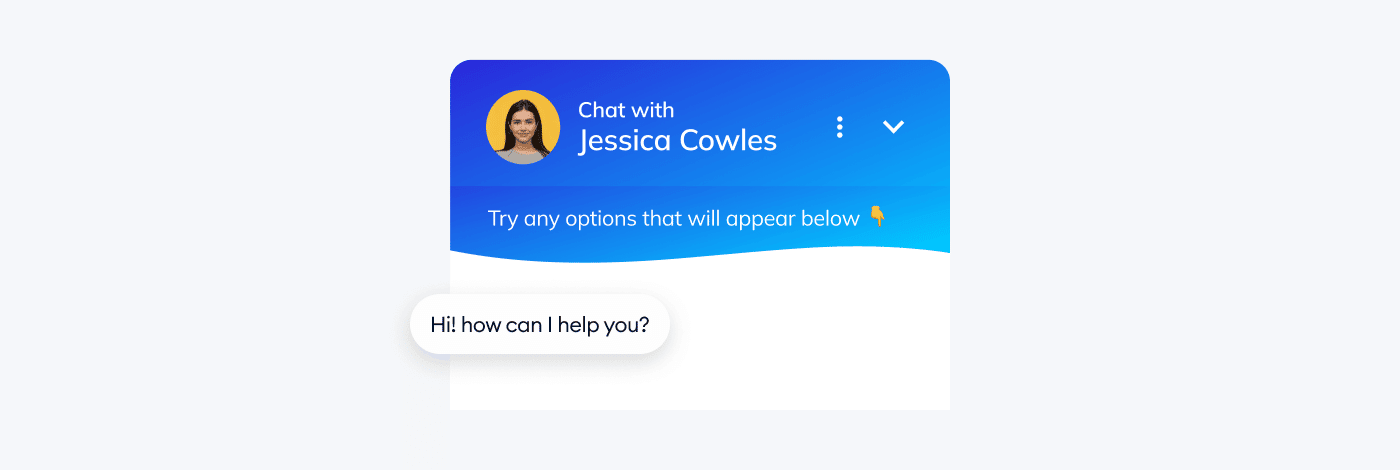
Whether you do this using automated messages or if your customer service operator sends messages to users manually, it all has the same purpose. And that is to engage customers and get them to talk to you.
Read more: Find out all you need to know about customer engagement, its importance, and the best strategies.
But to better understand the idea behind using proactive chat, it will also be useful to mention reactive chat as well.
What is proactive vs reactive chat
It can be argued that reactive and proactive chat are complete opposites—so let’s explore some of the core differences between the two.
Reactive chat refers to all instances where a visitor makes the first move to contact the company’s customer service. Like, for example, clicking on the live chat button to start a conversation with a company’s agent.
On the other hand, proactive live chat requires you to use a strategy of approaching a customer and letting them know you’re there for them. And the more personalized the message, the better.
But, you should also keep in mind that there is always a risk of annoying customers or coming off too strong when you’re using the proactive approach.
Still, most shoppers want companies to reach out to them proactively.
In fact, a study by PR Newswire shows that 87% of adults in the US want to be contacted proactively by a company.
In addition, there is a risk that a customer that isn’t proactively approached would search for an answer on their own and not succeed to find it. And this could lead to them eventually abandoning your site altogether.
Here’s a comparison table that would help you understand the core differences between a reactive and proactive chat:
| Reactive Chat | Proactive Chat |
|---|---|
| Client has to reach out first | Company approaches the customer first |
| Shopper may feel shy or hesitant | Shopper feels valued |
| Customer leaves the site before finding what they’re looking for | Customer is approached at the right time and takes action |
| Danger of missing out | Danger of annoying the customer |
| Fewer chats/conversions | More chats/conversions |
Looking at the table above, it might seem clearer why using proactive live chat can be beneficial for businesses.
Let’s explore this even further—
Proactive live chat benefits
We’ve established that using a proactive approach can be more beneficial than waiting for your visitor to make the first step. So, let’s see what some of the key benefits of using proactive live chat are:
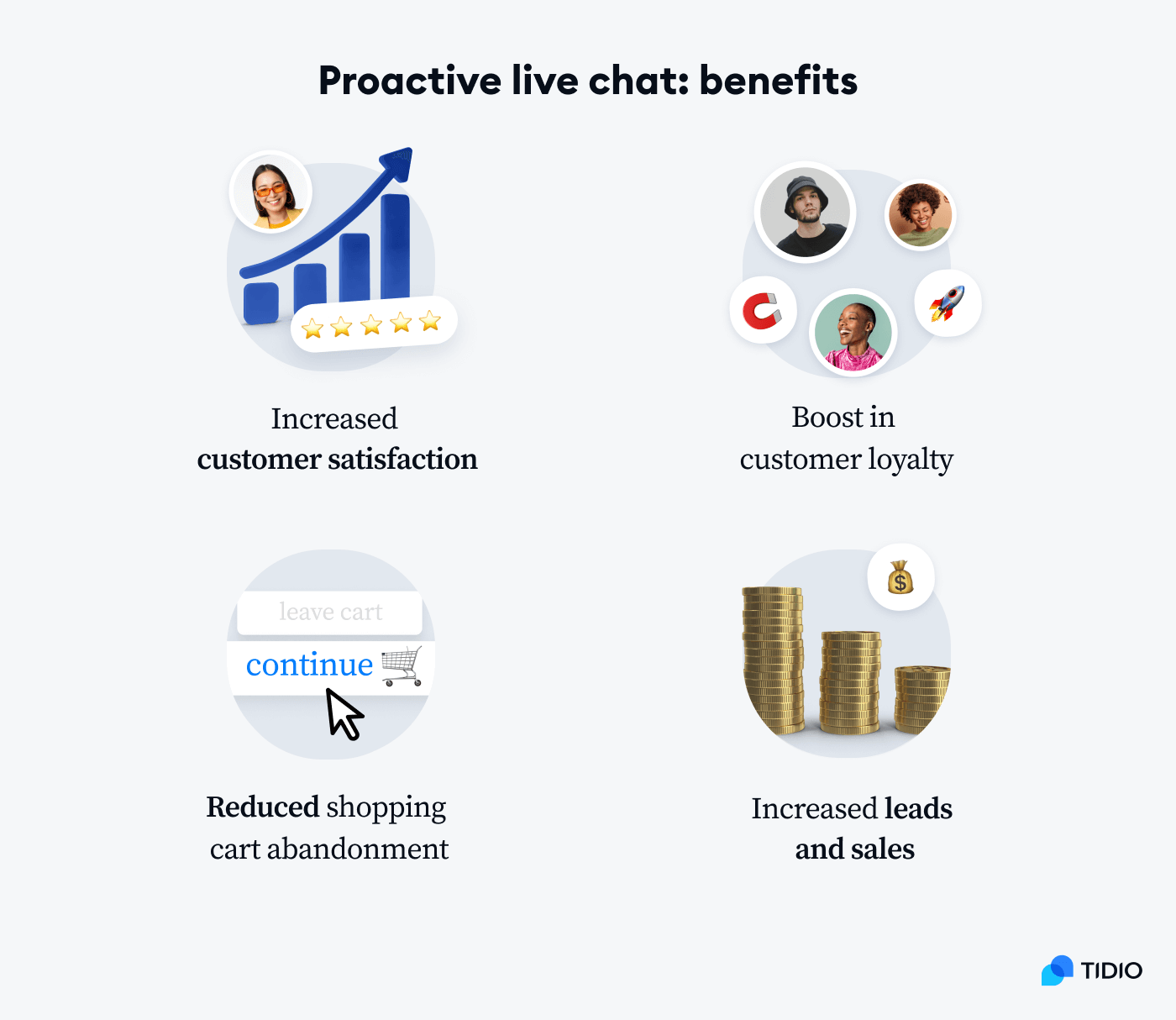
- Increased customer satisfaction
According to HelpLama, 89% of customers who got contacted proactively by a company found the experience to be positive. A whopping 92% of consumers said that the experience changed their perception of a company for the better, while 87% said a positive customer experience inspired them to take action.
When looking at all these customer service statistics, it’s easy to see that customers appreciate the proactive approach as it makes them feel properly attended to and valued.
Naturally, this can only lead to improved customer satisfaction as a whole.
- Boost in customer loyalty
Satisfied customers tend to become more loyal to the brand which made them feel appreciated as a customer in the first place. In fact, according to some live chat statistics, 51% of customers tend to buy again from a company that has live chat support. And incorporating the proactive chat strategy can only increase this number.
- Reduced shopping cart abandonment
According to Drip, average cart abandonment in all industries is 70%. That’s quite a high number, don’t you think?
But this shouldn’t intimidate you. Every 1% decrease in cart abandonment rate creates a path toward having a significant business boost. And this is exactly where proactive live chat can help you out.
By taking proactive steps to reach out to your customers, you increase your chances of reducing the shopping cart abandonment rate on your online store. You just have to choose the right moment to engage your customers and stop them from abandoning their carts before it’s too late.
Read more: Read our list of top 15 inspiring ecommerce case studies and find out how the best online stores used live chat tools to reduce shopping cart abandonment.
- Increased leads and sales
Proactive chat can help you target the right customer at the right time. By doing so, you can accomplish anything from generating more leads to getting a boost in sales and revenue in the long run.
Read more: See how an Italian cosmetics ecommerce recreated in-store experience online with live chat and chatbots.
Now that we explored some of the live chat benefits, it’s time to dive even deeper—
Proactive chat examples
To help you understand how you can use the benefits of proactive live chat to your advantage, it’s best to showcase some practical examples.
Check out some of the best proactive chat use cases suggested by our live chat experts:
- Sending a proactive welcome message to new visitors
- Sending a message to returning visitors
- Providing a quick FAQ
- Placing a discount on the first order
- Using the Cart Booster to reinforce the buying intent
- Recovering abandoned carts and learning why customers leave checkout
- Sending product recommendations
- Sending a message when a customer spends a long time on page
Without further ado, let’s dive right in.
1. Sending a proactive welcome message to new visitors
One of the best, albeit most basic examples of using proactive live chat is sending a welcome message when a new visitor arrives at your site for the first time.
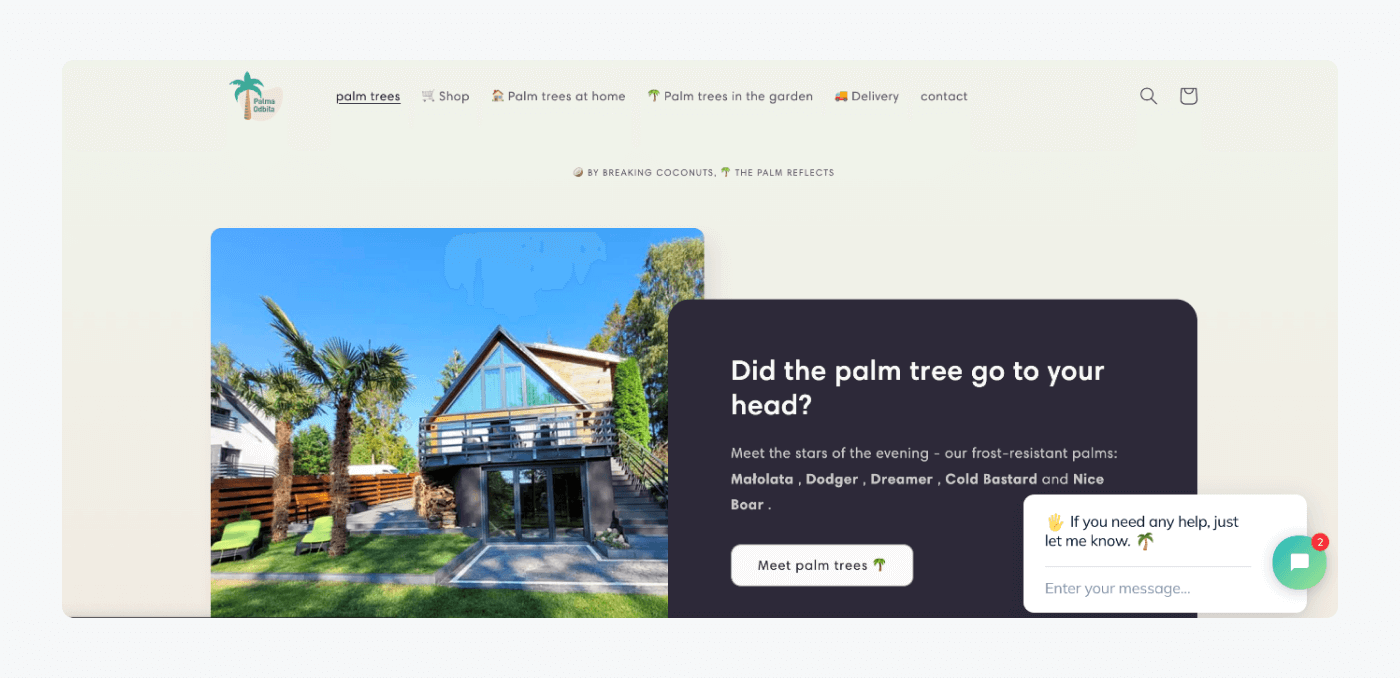
There is a high chance new visitors aren’t yet aware of all of your products and things you can do. In other words, they’re just getting to know your brand.
So, take into account that they will probably need more assistance from you than others. But give them time and don’t be pushy!
New visitors will need to look around and process things they see on your webpage before they even start considering whether they need any help from you. In other words, the right timing is crucial here.
The trick is not to reach your new visitor too early in the process. Giving them a bit of time to look around your page before messaging them might be the best way to properly engage them from the start. Try sending your proactive message with a 10-second delay.

2. Sending a message to returning visitors
Another typical example of proactive live chat is sending a message to a visitor that has already visited your page before. This is a perfect opportunity to offer more personalized communication for the shopper. That way, you can make them feel even more appreciated, increasing your chances of scoring a lead or sale.
Some types of live chat software also include a useful visitors list feature. This kind of functionality gives you access to real-time monitoring of your visitors.
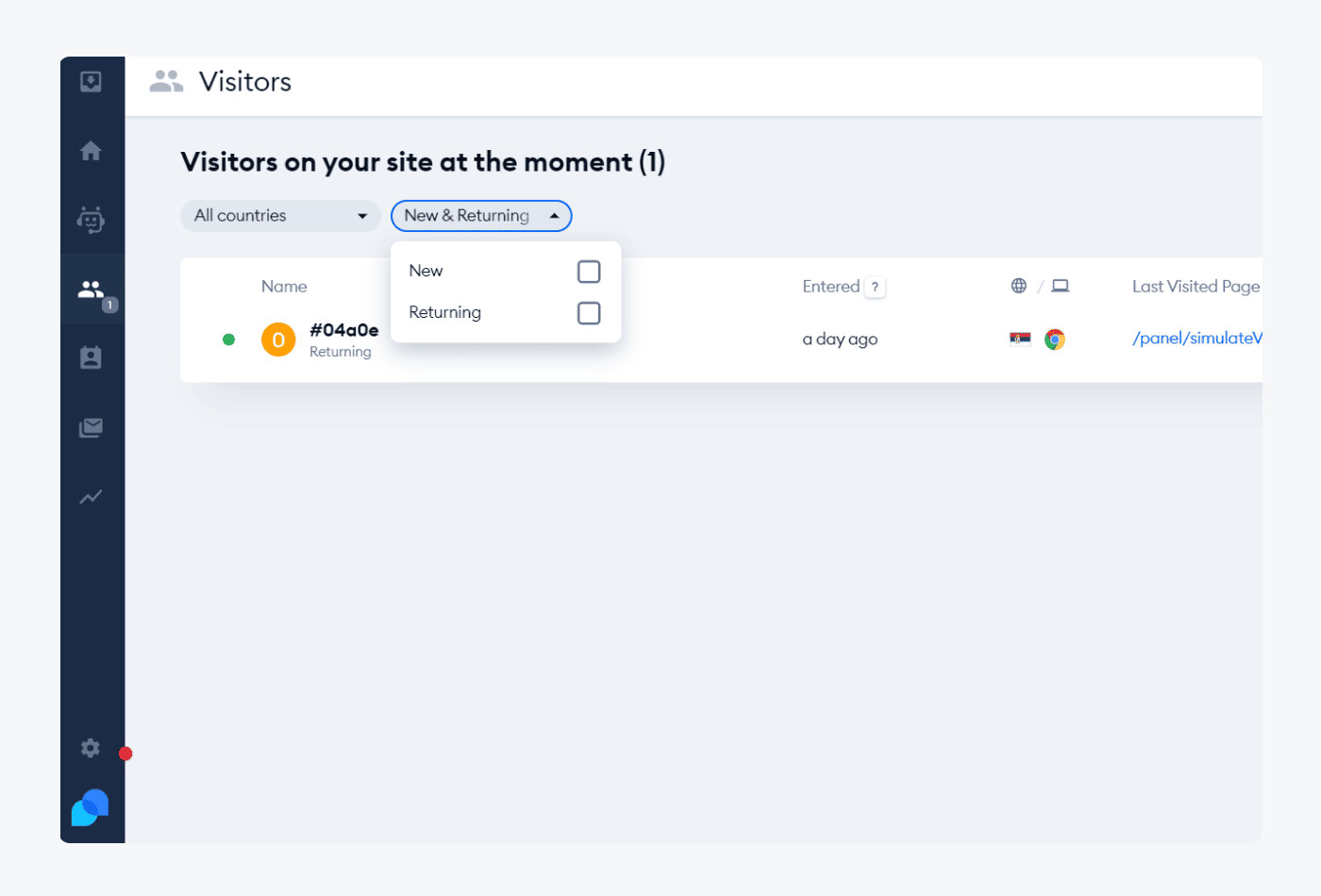
You will be able to see what specific types of visitors are doing on your site at any given moment. You can also see where they’re coming from, whether they’re returning or new visitors, what type of platform they’re using, etc. All these bits of info can help you easily reach the right type of visitor at the right time.
3. Providing a quick FAQ
Another great example of proactive live chat is sending a message to visitors who are looking for a particular answer.
For example, you can set your messages to appear when the website visitor spends more than two minutes on a product page. Or, if they visit a frequently asked questions (FAQ) page, you can have your chat window pop up when they scroll halfway to the bottom of the page.
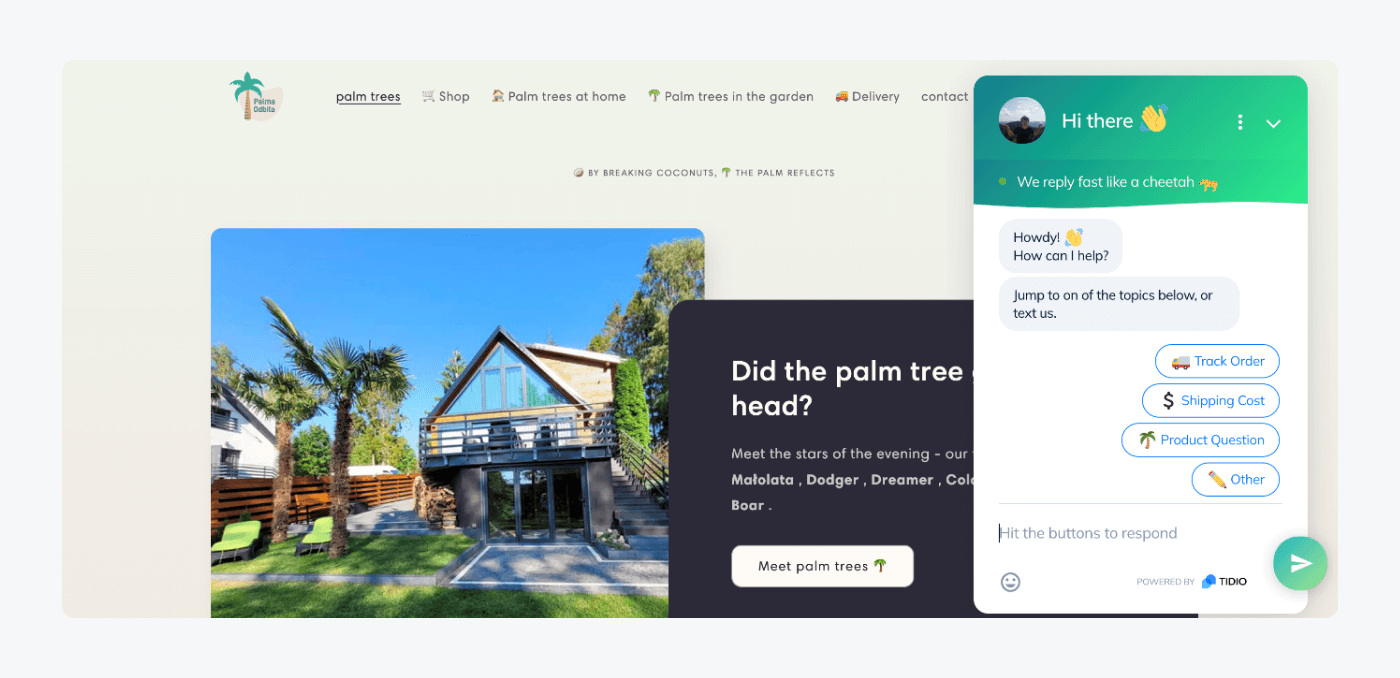
4. Placing a discount on the first order
Nowadays, retailers often offer discounts to new shoppers on their first purchase. If you can go to any popular ecommerce brand and scroll for a while, or try to leave the page, you’ll likely receive a popup that promises 5, 10, or 20% off in exchange for your email address.
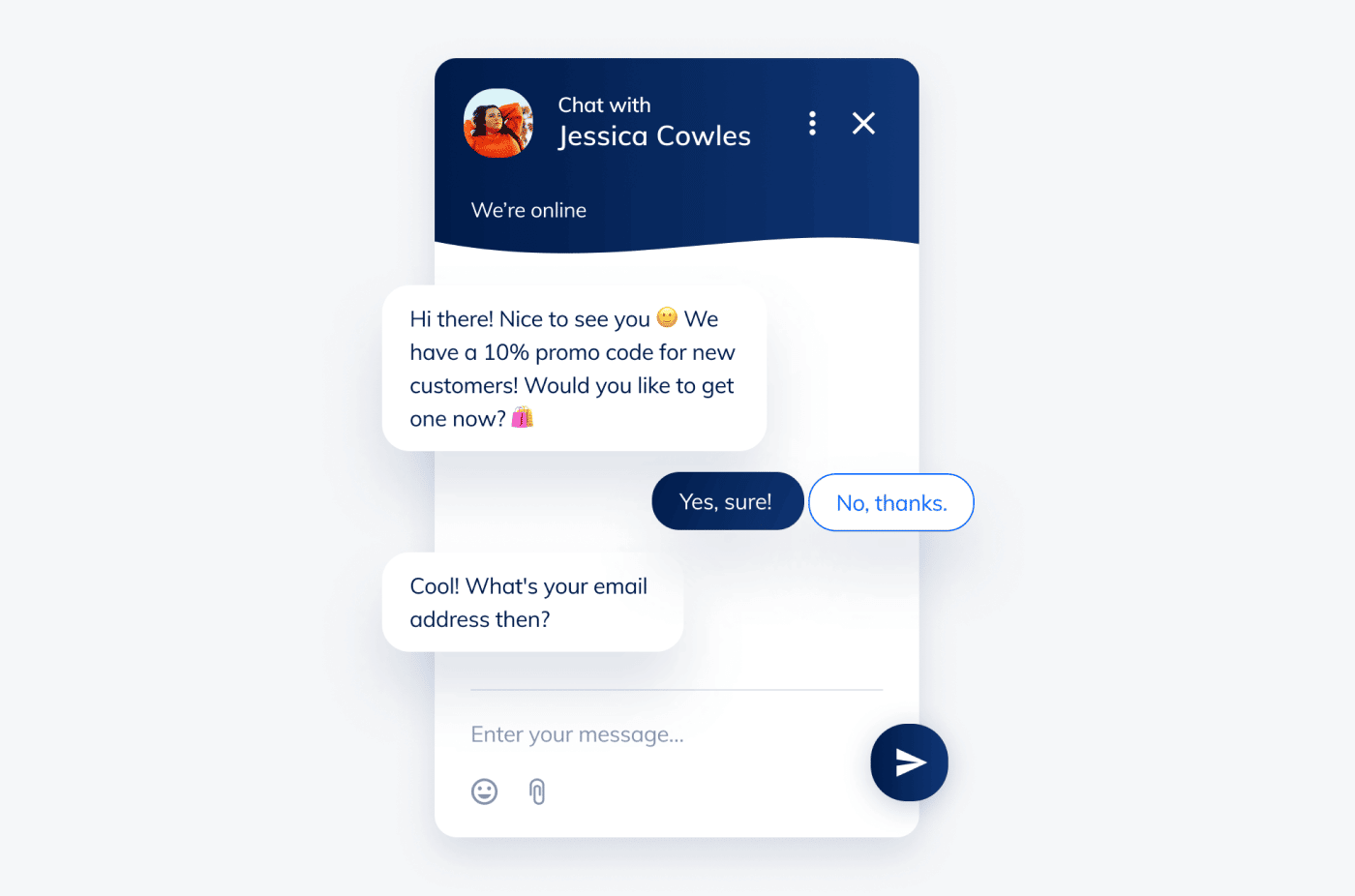
But unlike a popup, a proactive live chat message that appears in a chat box is more discreet and less annoying or intrusive. Try sending this type of proactive message with a discount to a new customer that visited your store for the first time. This strategy can help increase your conversion rate immensely.
Read more: Check out these effective ideas that can help to increase your ecommerce conversion rate.
5. Using the cart booster to reinforce the buying intent
Every time a customer adds a product to the cart, it can result in a successful purchase. When you take that into account, it’s easy to see how sending a proactive message to shoppers could be useful for boosting sales.
Try including a limited-time offer or a discount in your message to a person who just added products to the cart. The discount they get to use at the checkout can really push a visitor to go for the purchase and become a customer.
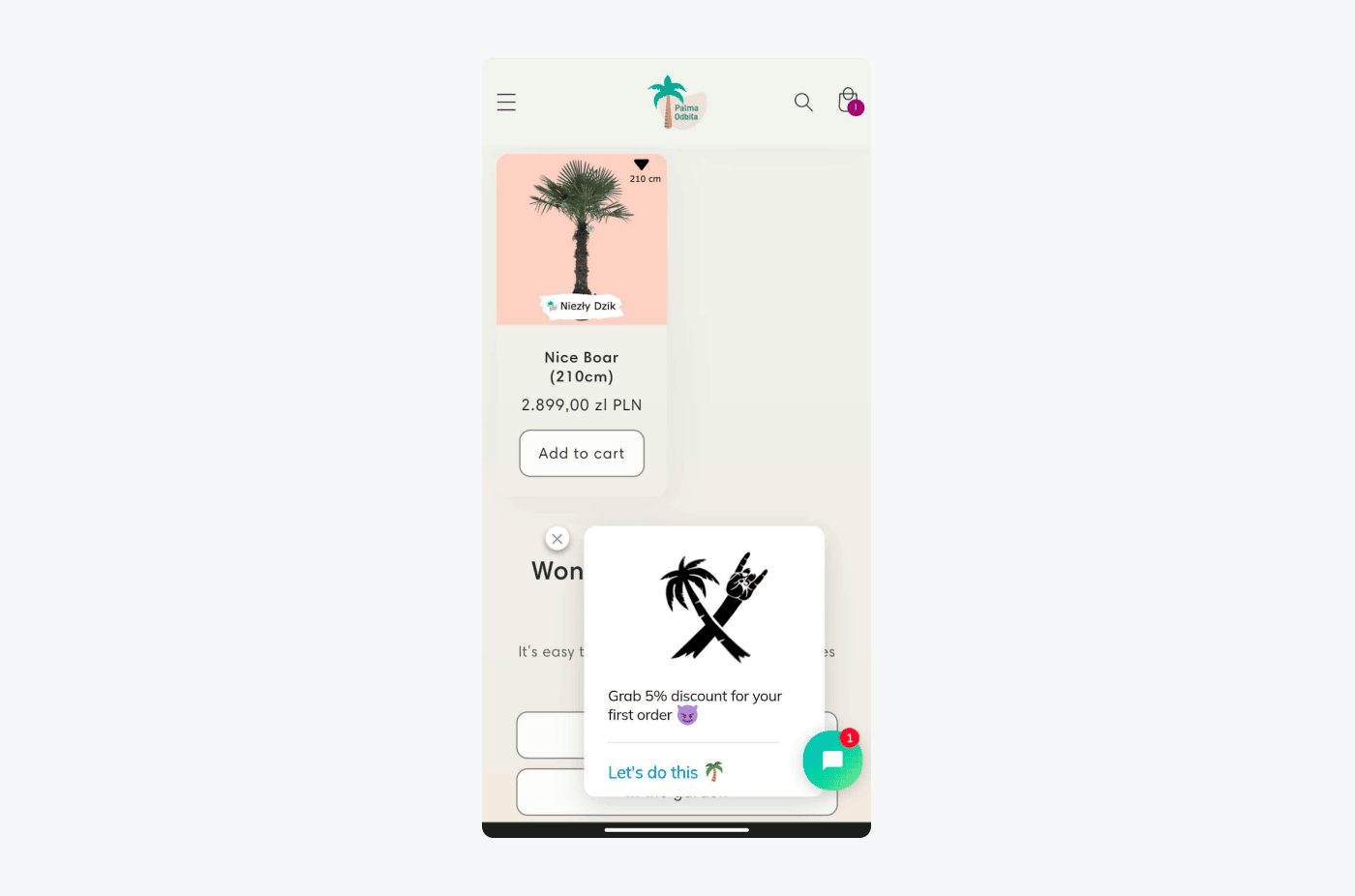
6. Recovering abandoned carts and learning why customers leave checkout
Here’s a proactive online chat example that can really help you improve your ecommerce store’s conversion and bounce rate—once a customer decides to abandon their checkout page, you can send them a message asking for their feedback on why they abandoned their cart in the first place.
Then, according to their answer, you can offer them a discount, or suggest similar products to convince them to complete their purchase.
You can also simply use the information they provided to improve the cart and checkout experience of your shoppers in the future.
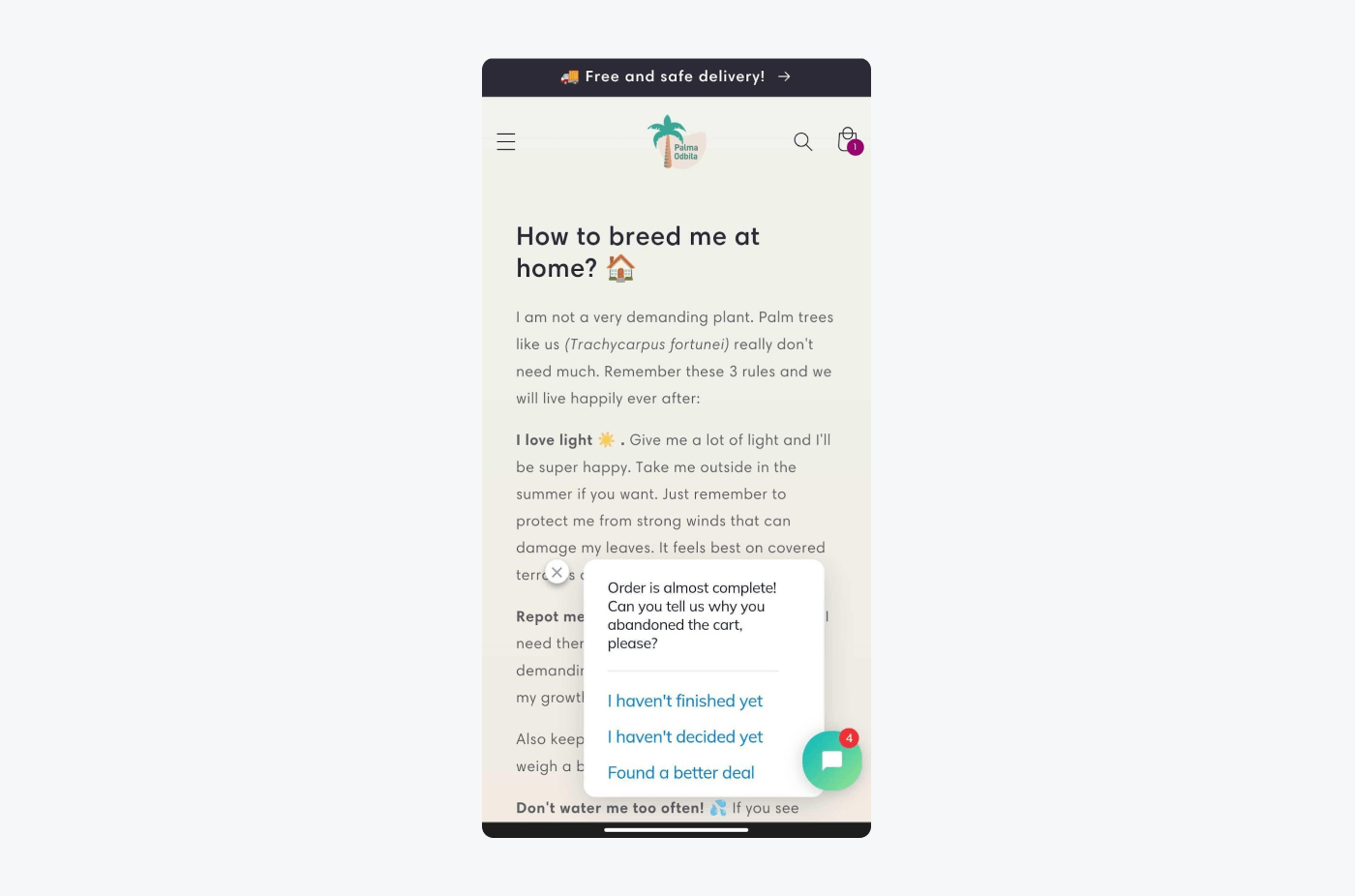
7. Sending a product recommendation
It’s safe to say that product recommendations are considered the gold standard of a proactive customer approach. That’s because they let customers find exactly what they need quickly and effectively.
You can use a sales chatbot to send personalized product recommendations, as well as upsell and cross-sell to your customers. Additionally, you can get to decide the timing, place, and types of products you wish to recommend to your customer, which leads to a truly tailored experience.
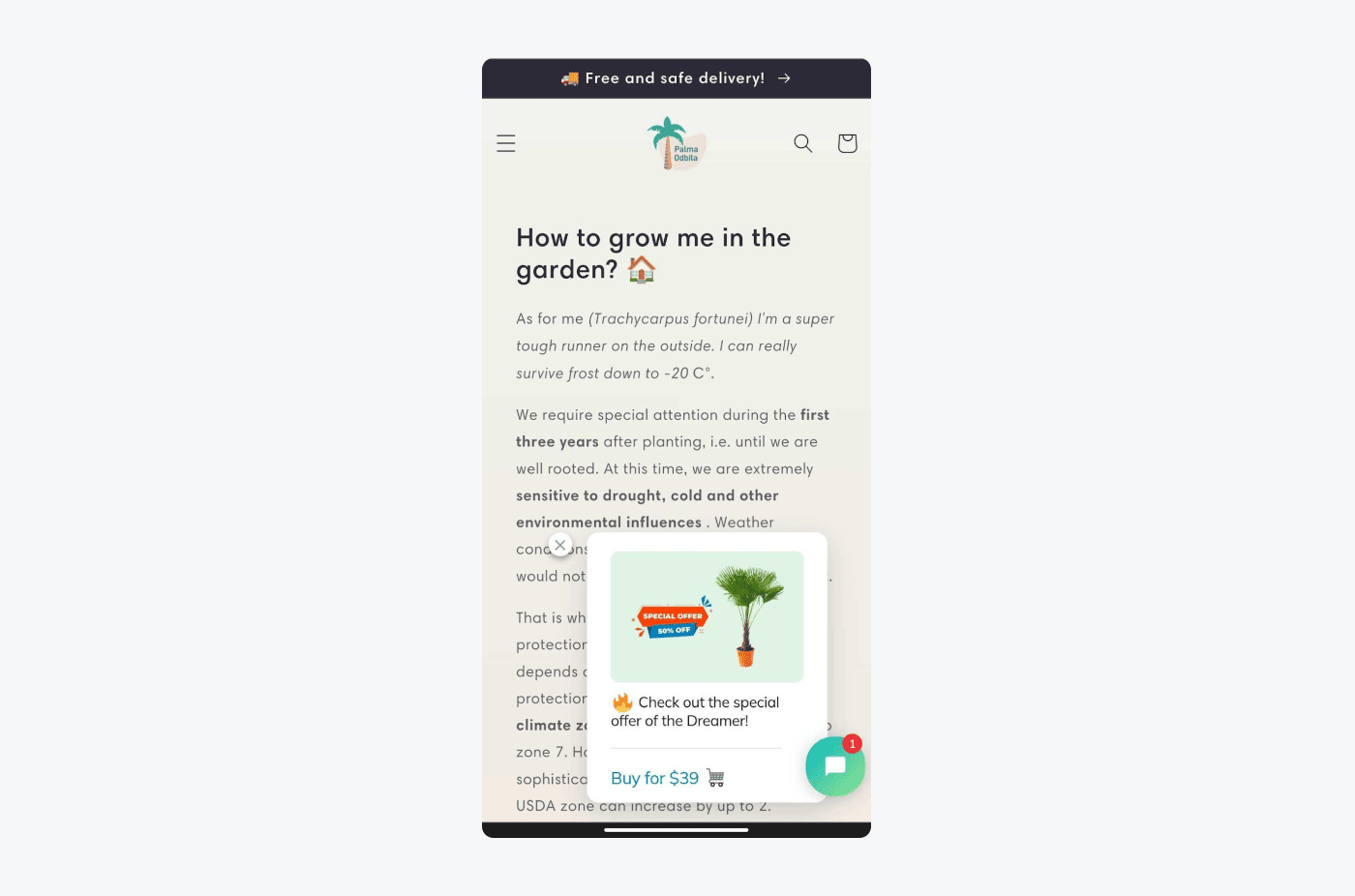
8. Sending a message when a customer spends a long time on the page
If a visitor spends lots of time on your website, this can usually indicate two things— they are either getting fully immersed into the content, or they need some sort of assistance.
To truly engage such customers and detect the buying intent, you can simply invite them into a live chat conversation with you by sending them a tailored message. It’s a good idea to do this after they spend a specific amount of time on your page (i.e. 5 or 10 minutes).
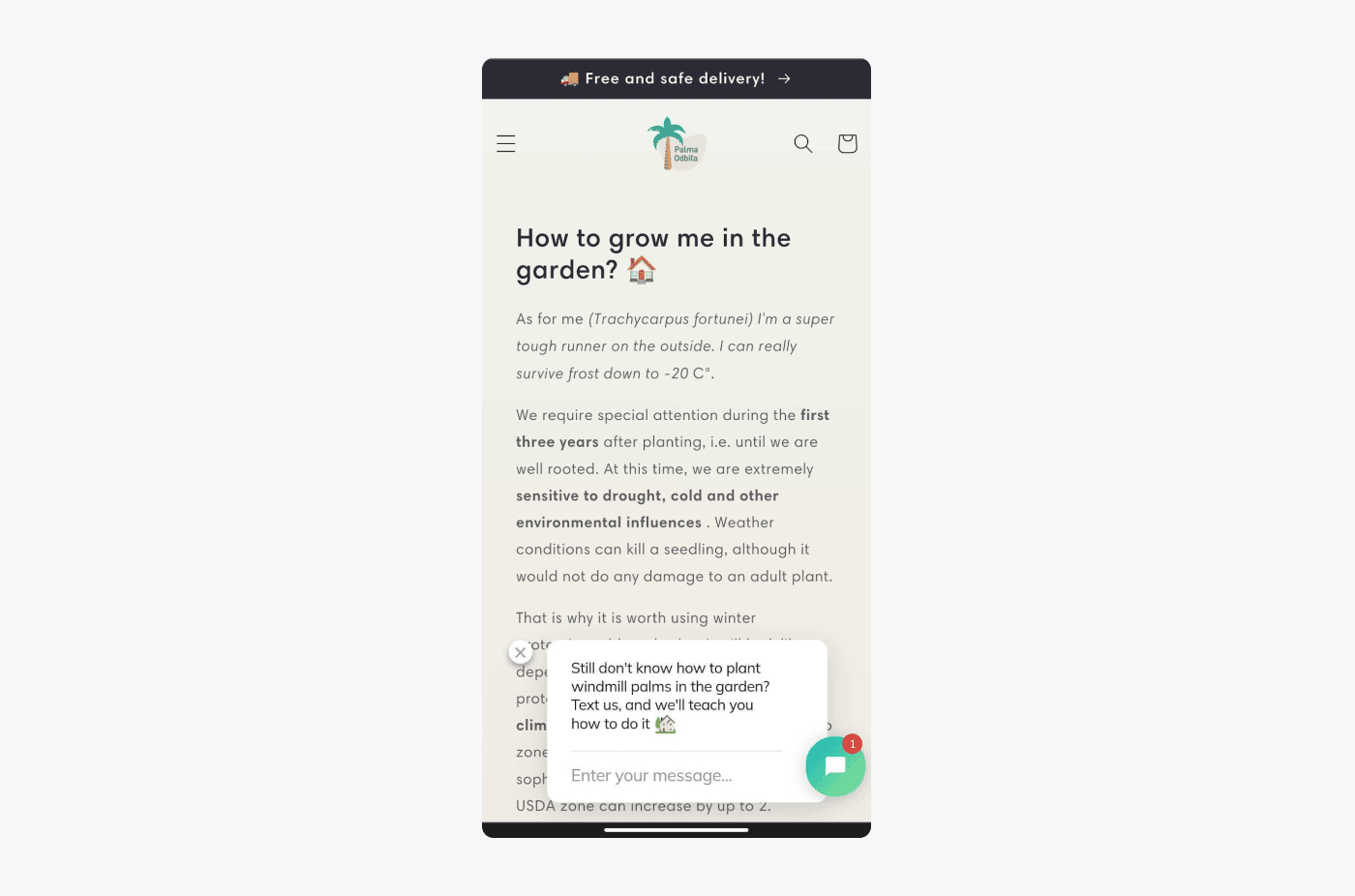
Now that we’ve gone through some of the most practical use case examples of implementing proactive live chat on your website, it’s time to share some handy tips.
Proactive chat best practices and tips
Check out these best practices that will help you refine your proactive messages to perfection:
1. Automate your proactive live chat with chatbots
Using a powerful live chat tool to send well-timed messages to potential customers is one thing. But automating your messages with the help of chatbots can be a complete game-changer for your business. In other words, if you decide to use a chatbot, you will be able to incorporate all use case examples mentioned earlier—and then some.
To make the most out of your proactive live chat, you should try setting up some triggers. Simply put, triggers are chatbot nodes that will let a bot know when to send your messages. You can use triggers to help personalize each one of your messages even further.
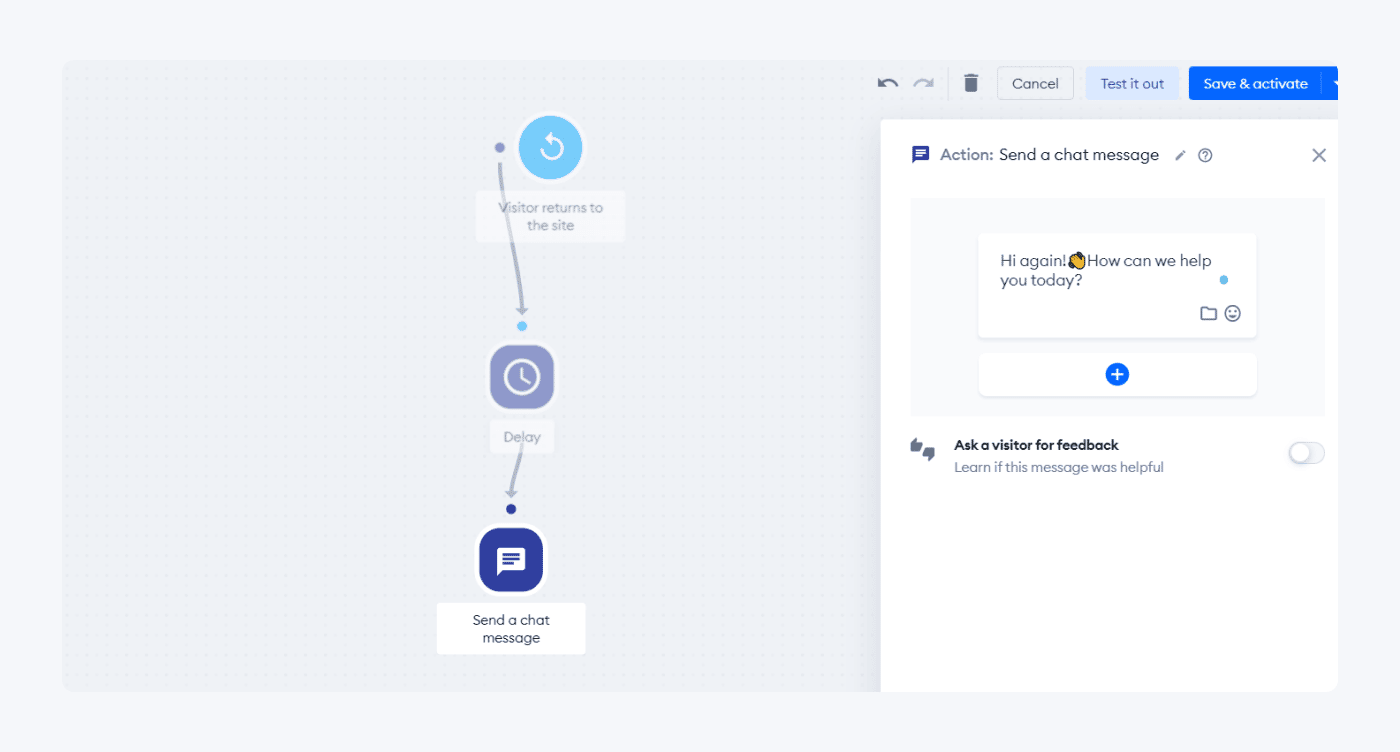
For example, you can add live chat triggers for a new or returning visitor. In addition, you can set triggers when a visitor opens a specific page, scrolls to a certain section, clicks on a button or product, and so on. Then, you can make a chatbot send a message according to any of those triggers.
Chatbots will also allow you to pick the conditions under which certain messages will appear to make things even more specific, i.e. if a person is from a specific country or if they’re using a specific operating system.
Make the most out of proactive messaging with Tidio
Read more: Discover how to use triggers with Tidio and take your proactive messages to the next level. Also, you can learn more about the core differences between chatbots vs live chat.
2. Set up messages to appear at the right place at the right time
This goes without saying, but it’s important to emphasize it nonetheless. The right place and timing are everything when it comes to proactive messages.
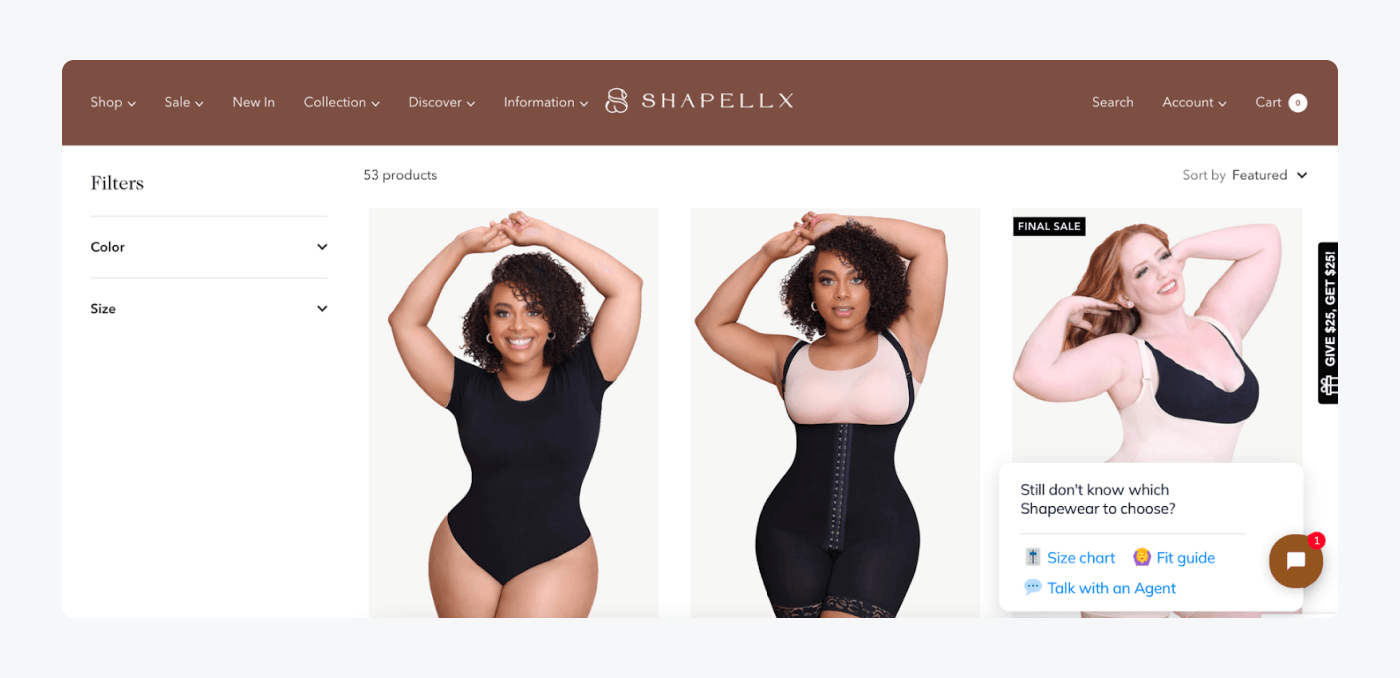
If you send your proactive chat message to the person who’s just abandoned the cart a few seconds too late, they might abandon your website entirely.
As you can see from all proactive live chat examples above, the timing can be heavily dependent on the intent and the type of the current page a user is viewing.
For example, you shouldn’t bombard a person that’s viewing your product page for the first time with messages. However, if they spend longer than a minute to proceed to checkout, then you should proactively message them.
Aside from using common sense, you can always check your live chat and chatbot analytics with a tool, like Google Analytics. This way, you can get some valuable insights into the average time visitors spend on certain pages. Then, automate the message accordingly.
Read more: Learn how to integrate Tidio with Google Analytics.
3. Personalize your messages— it truly matters
In the highly competitive market where businesses all strive to create a memorable experience for their customers, personalization is everything. It’s the one true aspect of branding that can help your business thrive.
Personalization is more than just a bonus for doing business. Personalized experiences build brand loyalty, boost customer satisfaction, and make people remember your business. Recent research reveals that 80% of consumers are more likely to purchase from a brand that offers personalized experiences.

It’s important to always keep personalization in mind when sending messages to specific users. For example, a new visitor will require a more general approach as you have yet to learn what their needs are.
But a person viewing the pricing page could appreciate a proactive message that goes something like this:
Hey there! I see that you’re browsing through our pricing page. Can I help you out in case you have any specific questions about our pricing?
And a customer browsing a specific product category will appreciate a similar product recommendation, an offer, or a discount.
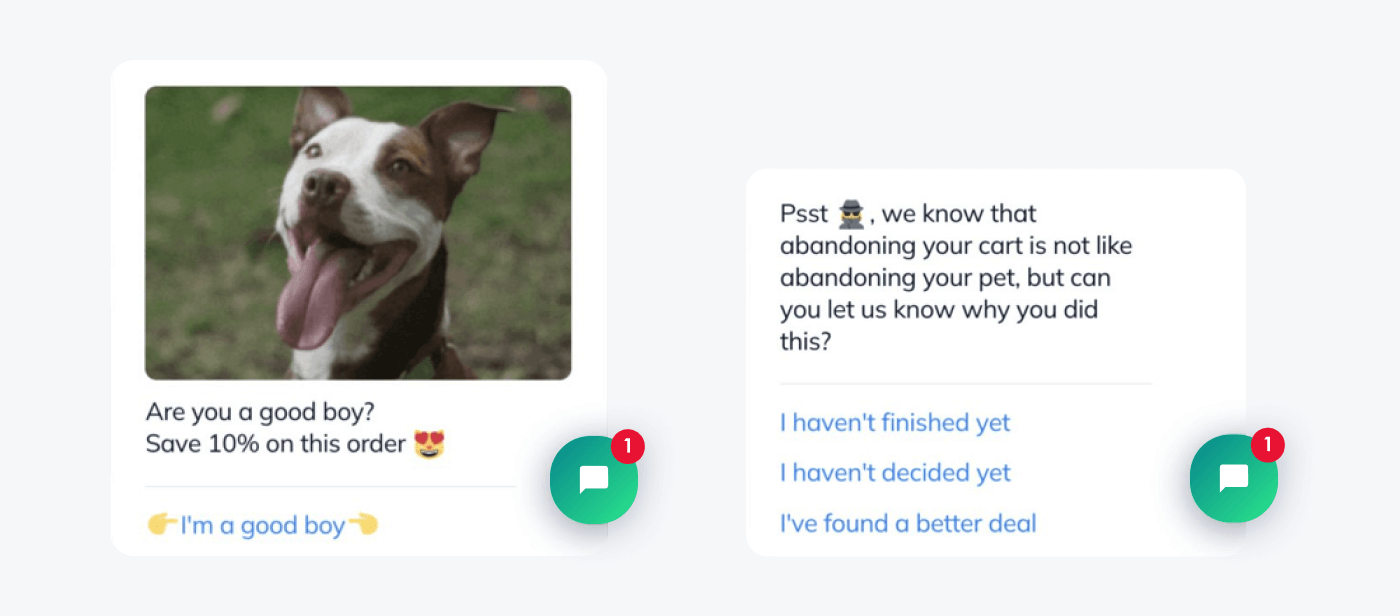
4. Customize the look of your chat widget, too
Personalization is not just about sending the right message to the right visitor— it’s about the look of your chat as well.
This is where adding a more personal touch to your live chat widget can help.
Most live chat and chatbot software come with ready-made templates that can be used by default. But adding little tweaks here and there can make them appear much more specific to your brand and, well, human.
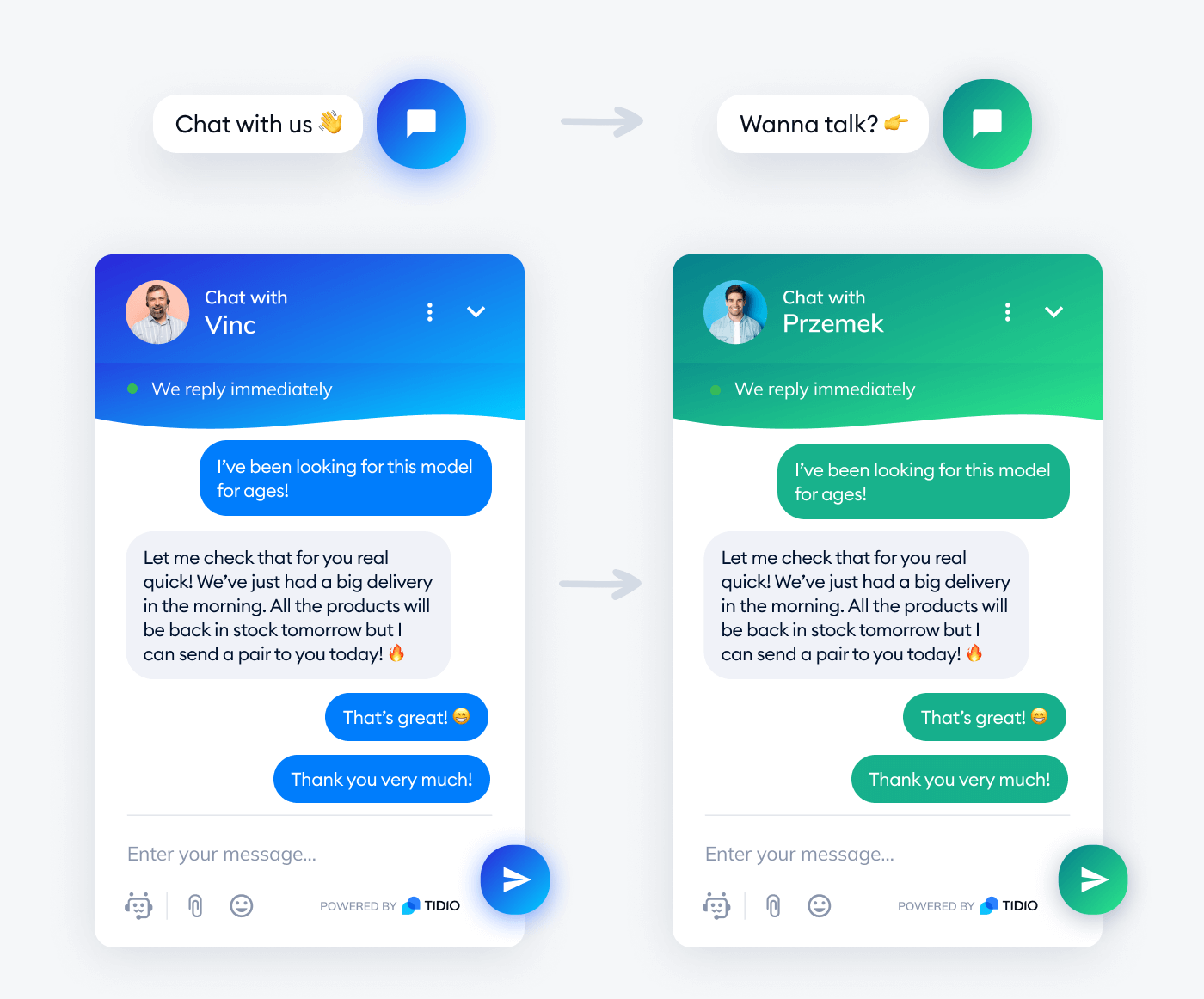
You can add small details like photos or avatars, online/offline statuses, and label text. Even just changing colors and the message copy to fit your brand more can make all the difference and give “soul” to your proactive approach.
Read more: Check out our knowledge base and get familiar with Tidio chatbot templates and how to use them.
5. Send a minimal amount of messages
While sending proactive messages to customers can benefit your business in many ways, it’s still best not to overwhelm them with too many at once. In other words, it’s always better to keep things to a minimum.
Let’s say that a customer is visiting your site for the first time. It wouldn’t make sense to send three consecutive messages at once about, say, offering help, a discount, and FAQ page info.
It would look unnecessary at best, and spammy at worst, wouldn’t you agree?
It’s always better to send one concise but informative message at a time. Moreover, if the message you send is being ignored, then sending another one probably isn’t a good idea.
Finally, make sure that a message has a single intent not to confuse a visitor. By focusing on one meaningful subject per message, you give a person the appropriate amount of space to reply.
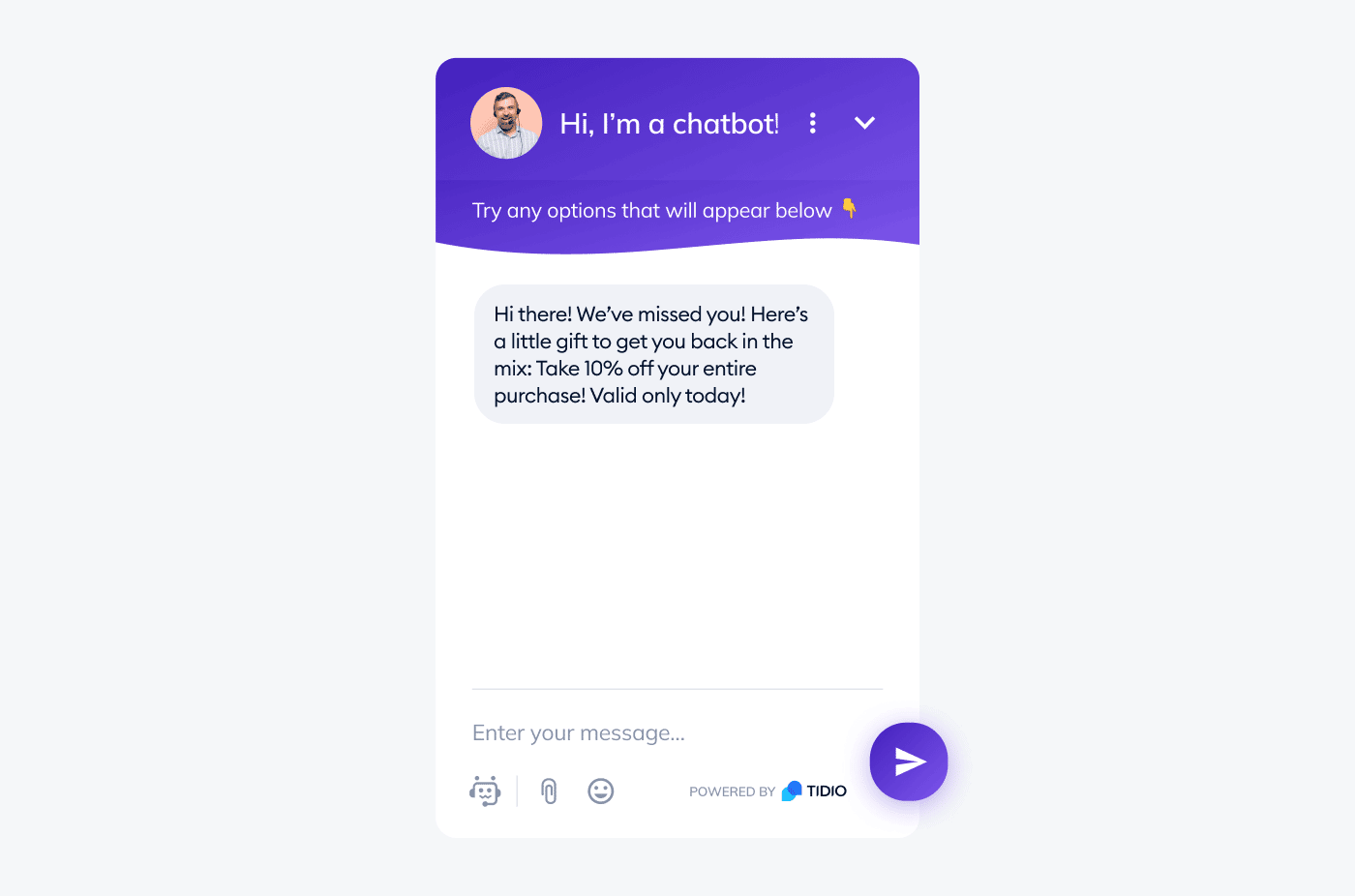
Finally, let’s check out a list of the best proactive live chat software you can use to put our advice into action.
Proactive live chat software: a list of best solutions
Now you know why using proactive live chat is excellent for your business. Also, you are more familiar with some of its practical use cases, as well as best practices of live chat etiquette.
However, sending proactive messages to your customers wouldn’t be possible without using the help of the appropriate live chat tool.
Before we talk about each software in more depth, let’s check out the comparison table that contains the ranking of the best proactive live chat software available on the market:
| Proactive live chat | Rating | Free plan/trial | Best for |
|---|---|---|---|
| Tidio | 4.7/5 ⭐️ (1,315+ reviews) | ✅ | Ecommerce businesses |
| Zendesk | 4.3/5 ⭐️ (5,425+ reviews) | Free 30-day trial | Customer support tool for mid-sized and large businesses |
| HubSpot | 4.4/5 ⭐️ (1,660+ reviews) | ✅ | CRM software integration |
| Olark | 4.3/5⭐️ (220+ reviews) | Free 14-day trial only | Marketing and survey features |
| LiveChat | 4.5/5⭐️ (745+ reviews) | Free 14-day trial only | Chat supervision |
| JivoChat | 4.8/5⭐️(45+ reviews) | ✅ | Multilingual support |
With that out of the way, let’s dive a bit deeper.
Here are the reviews of the top proactive live chat tools with pros, cons, and pricing.
1. Tidio
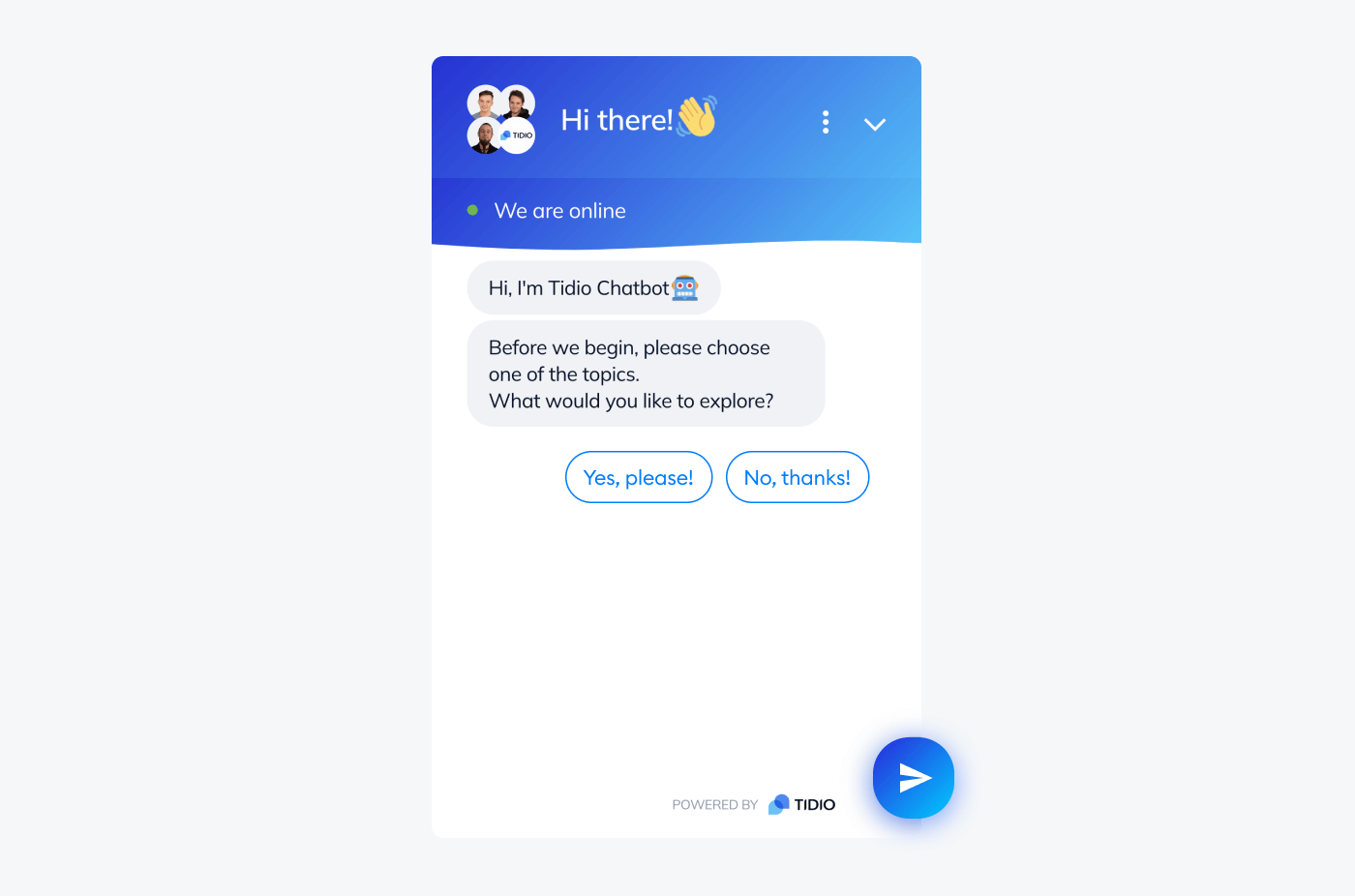
Rating: 4.7/5 ⭐️ (1,315+ reviews)
Now, it would be so easy to brag about our own tool here. But we’ll keep it short, as our blog is not the right place for that.
So—
Tidio comes with ready-made chat triggers that will let the chatbot know when to launch and send proactive, personalized messages to your customers. There is also a practical live visitor list feature to help your customer support see who is visiting your website in real-time, in case you want to send proactive messages to your visitors manually.
But why believe our word for it when you can check out Tidio yourself and register for free? You can also look through our customer reviews and see what our users say about us.
Main features:
- The ability to automate answers for most common and repetitive questions (like checking order status and processing returns)
- AI-based chatbot to automate your customer service and reduce the workload of your support team
- Premade triggers and actions, the ability to set custom conditions
- Live visitor list with info like contact details and location
- Live typing preview to see what your customers are writing in real time
- Fully customizable live chat widget to compliment your website
Pricing:
- 7-day free trial available
- Free version available
- Starter ($24.17/mo)
- Growth (starts at $49.17/mo)
- Plus (starts at $749/mo)
- Premium (starts at $2999/mo)
2. Zendesk
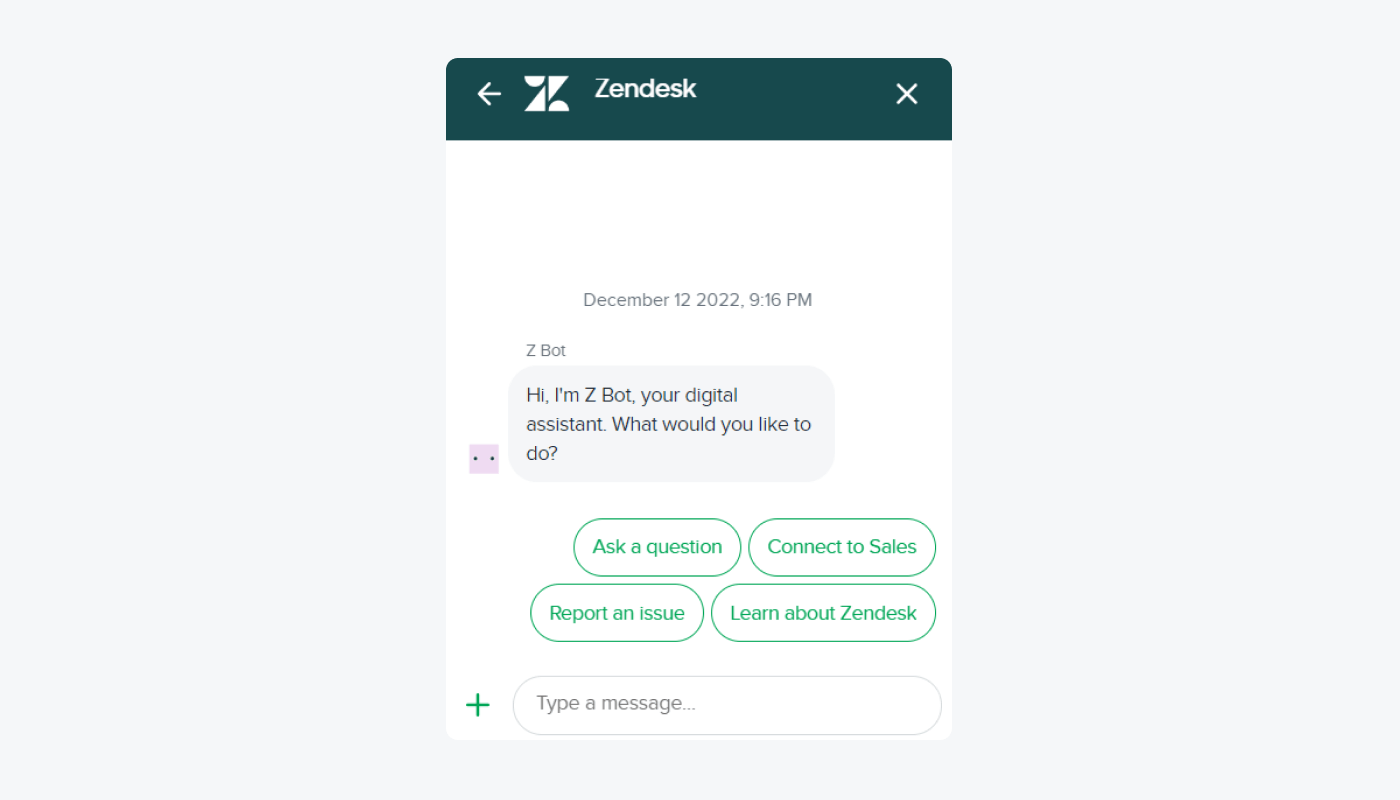
Rating: 4.3/5⭐️(5,425+ reviews)
Zendesk proactive live chat is an all-in-one customer support tool. You can use it to scale your service and offer support to your customers in a seamless manner.
With Zendesk’s AI chatbot technology, you can automate conversations and create entire flows using the flow builder feature. This will help you provide support 24/7 and use proactive messaging to truly engage your customers and prevent any possible escalations.
Pros:
- Flow builder to set a conversation between a bot and your customers
- Live preview to easily track your website visitors
- The ability to add messaging to your site, mobile apps, and social media
Cons:
- Reviewers report that certain modules are in conflict with each other at times
- Data transfer issues can occur
- Suite Team ($49 per agent/mo)
- Suite Growth ($79 per agent/mo)
- Suite Professional ($99 per agent/mo)
- Suite Enterprise ($150 per agent/mo)
- Additional plans (from $215 per agent/mo)
- Free trial: 30 days
3. HubSpot Live Chat
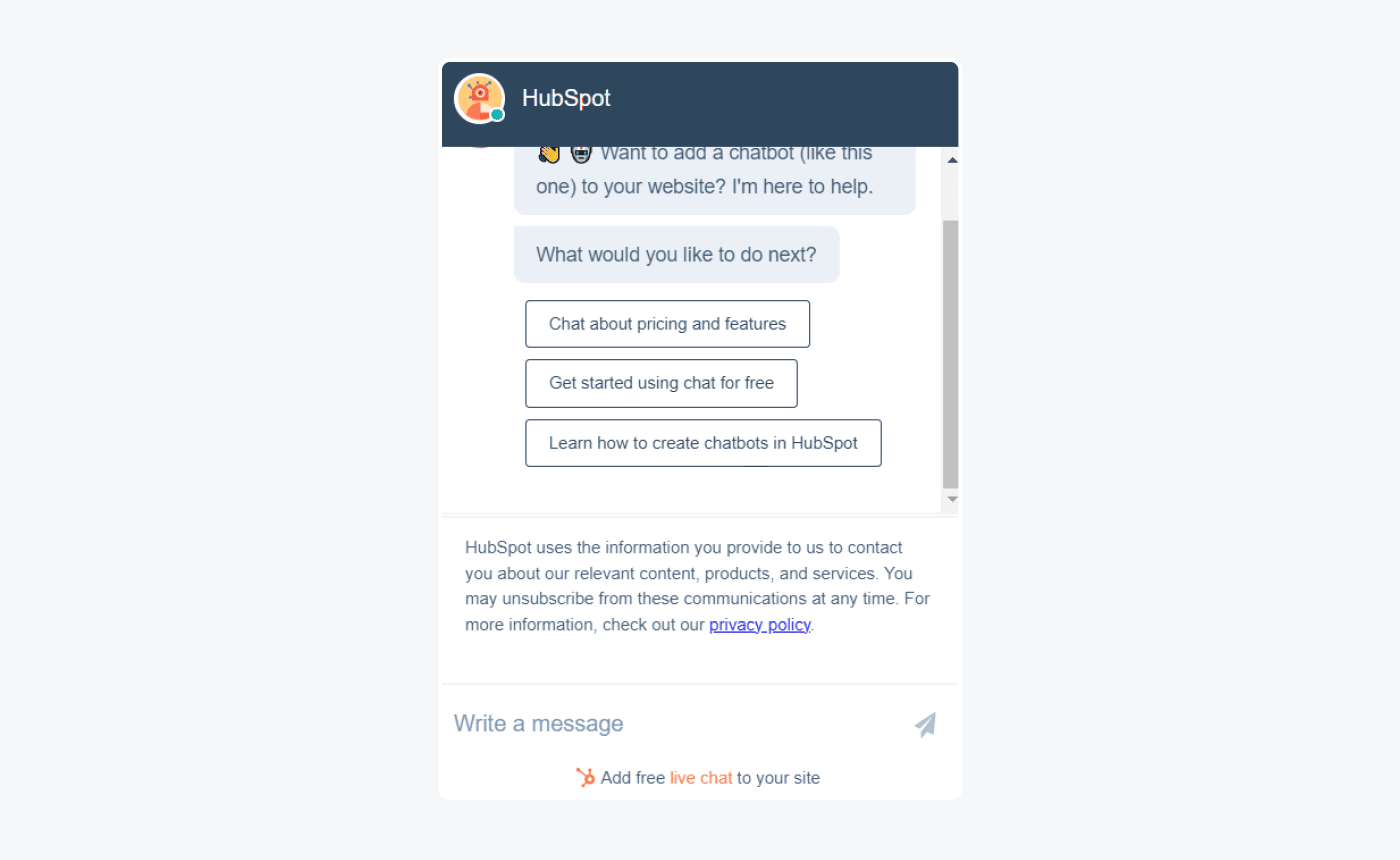
Rating: 4.4/5⭐️(1,660+ reviews)
HubSpot Live Chat is a freemium live chat software that can help you connect with your website visitors in real time. Some of the benefits of this proactive live chat tool include increased lead generation, boosted sales, and improved customer support.
As far as proactive messaging goes, you can easily create targeted welcome messages when visitors click on your pages. In addition, you can create messages for specific segments of your audience and connect with your visitors at the most appropriate moment.
Pros:
- Fully integrated with a chatbot builder to help you provide answers to commonly asked questions
- Contact activity to see how a visitor interacts with your website in one place
- The ability to customize your live chat widget to match your brand
Cons:
- Updates can cause a lag in the system
- Pricing is considered to be quite high
- Starter ($50/mo)
- Professional ($890/mo)
- Enterprise (starts at $3600/mo)
Read more: Check out detailed reviews of the best free live chat software solutions on the market.
4. Olark
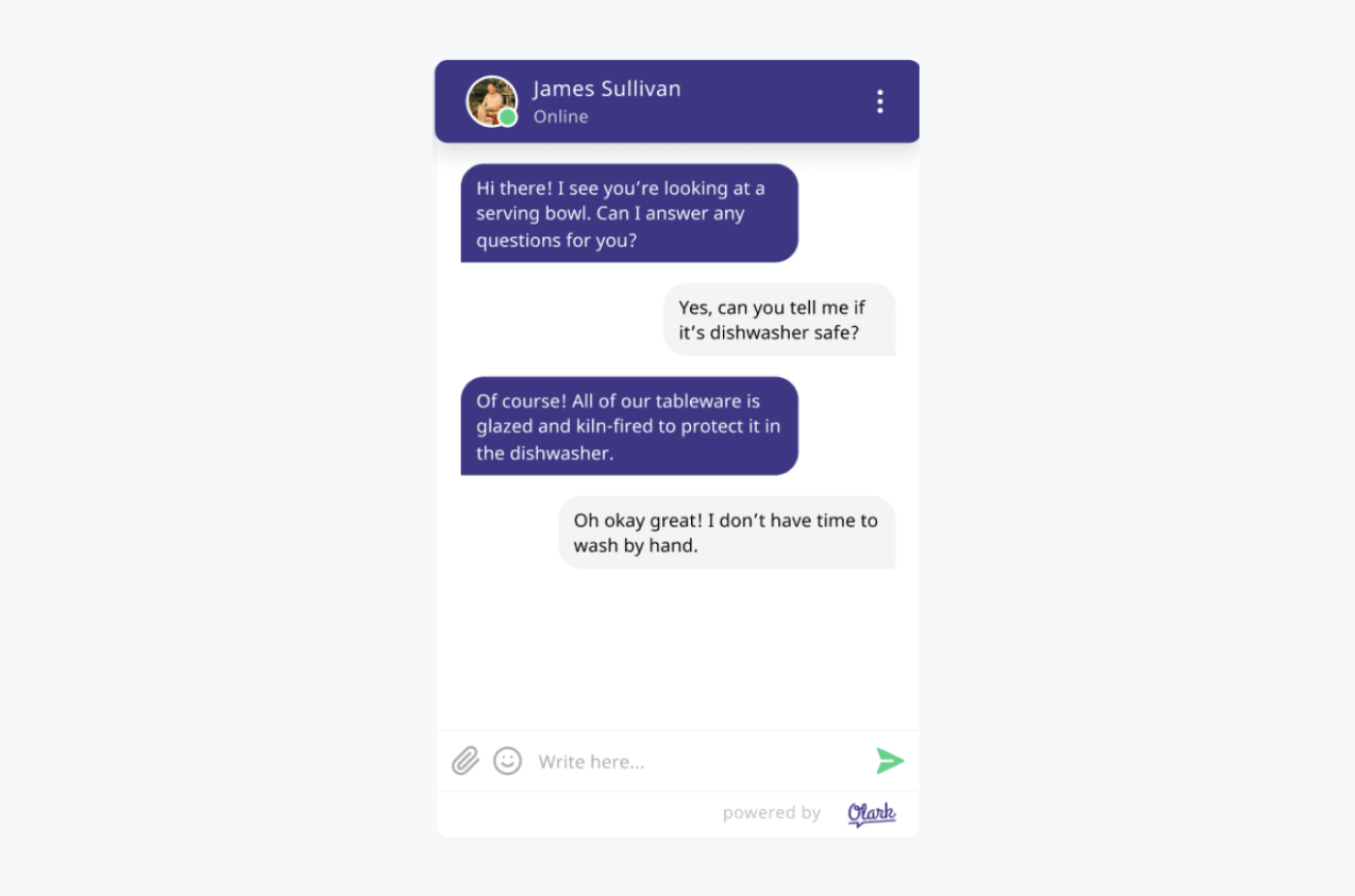
Rating: 4.3/5⭐️ (220+ reviews)
Olark is another great live chat tool that will make it easy for you to talk to your customers and address all their questions and concerns in a timely manner. You will get to use live chat insights and leverage the input from customers to improve your products and service.
If you want, you can automatically trigger messages for the proactive approach. These messages can be anything from a suggestion or a special offer that can be sent to your customers at the right moment.
Pros:
- The custom pre-chat forms feature to start a conversation with a customer and gather context before the chat begins
- Send automated messages based on criteria like location, referring URL, browsing behavior, etc.
- Live chat analytics with detailed reports to monitor chat volume and customer satisfaction
Cons:
- Sometimes the live chat support agents are displayed as offline or away when they’re available and online
- Customization isn’t very intuitive
- Free 14-day trial
- Standard ($29/agent/mo)
- Pro plan→ pricing available on request
Read more: Check out the detailed reviews of the best Olark alternatives to choose the right software for your business.
5. LiveChat
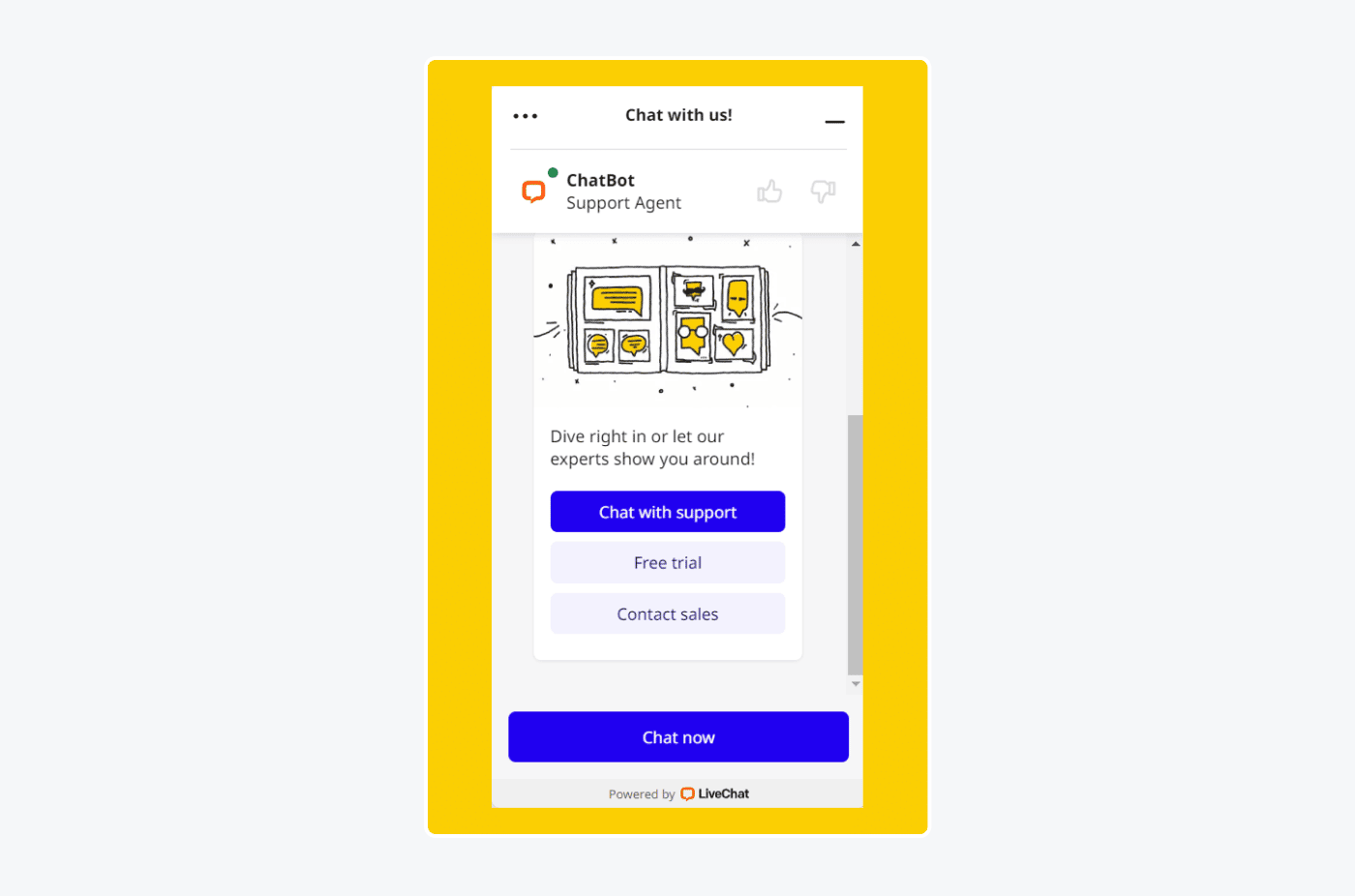
Rating: 4.5/5⭐️ (745+ reviews)
LiveChat is a proactive customer service live chat tool that can help you increase your sales. You can capture leads using its custom forms and AI chatbot automation.
Additionally, you can create targeted messages to introduce your products and interact with specific visitors based on their specific behavior.
Pros:
- Reports with customer satisfaction rating
- Canned responses to save time on repeated questions
- Inactivity messages to keep in touch with customers when support agents are busy
Cons:
- Some reports of technical glitches
- Limits to the number of agents that can be logged in
- Starter ($20 per agent/mo)
- Team ($41 per agent/mo)
- Business ($59 per agent/mo)
- Enterprise → available upon request
6. JivoChat
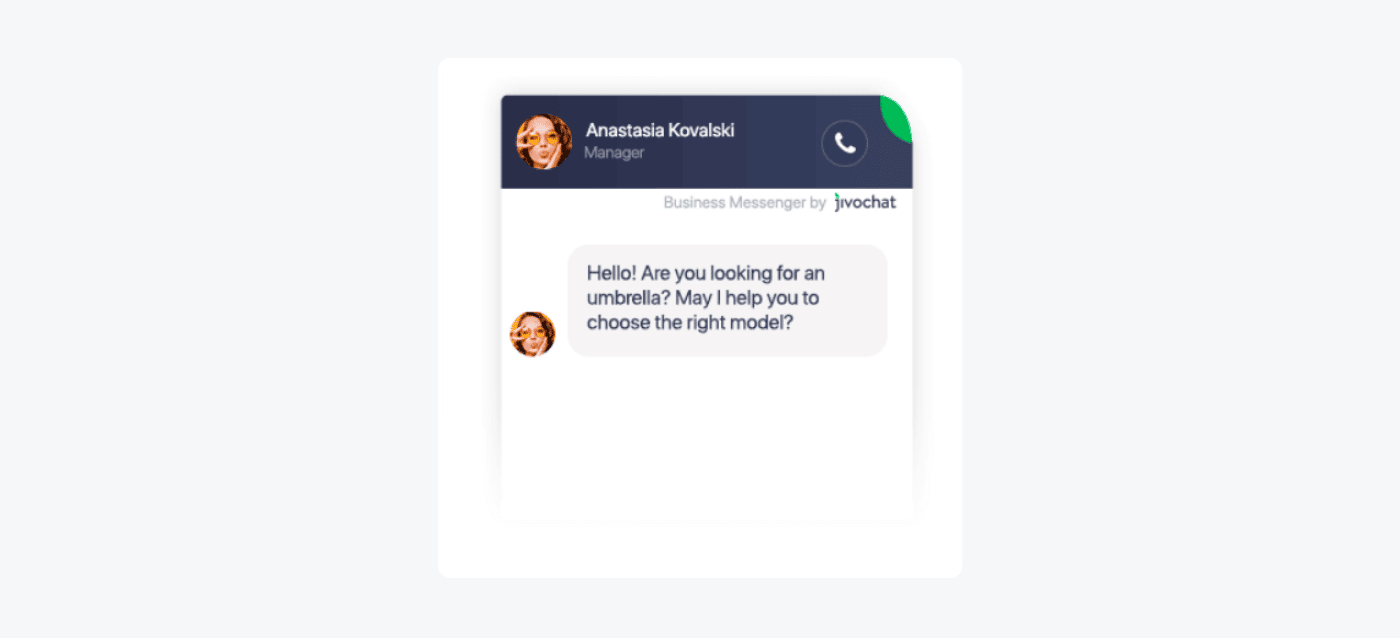
Rating: 4.8/5⭐️ (45+ reviews)
JivoChat is a simple but powerful live chat and chatbot software that lets you engage your visitors using proactive chat invitations. The JivoChat widget will allow you to handle multiple chats at once with complete ease. In addition, you can use its chatbot technology to help your customers at any time and from any device. Plus, you will get to easily integrate JivoChat with websites, messengers, or social media.
Pros:
- Integrate JivoChat into CRM or any other software including Pipedrive, Zapier, and Slack
- Chat widget can be translated into 20+ languages
- Website visitor info including location, source, and more
Cons:
- Live chat support is a bit slow to respond
- The settings are not as customizable as in other solutions
- Free plan available
- Professional ($19 per agent/mo)
- Enterprise → Pricing upon request
Read more: Learn all about best live chat apps for customer service.
Proactive live chat: key takeaway
Okay—that’s all from us today. Let’s review the most important information, shall we?
With proactive live chat, you can boost your customer engagement, reduce shopping cart abandonment, increase your leads, and boost sales.
Just make sure to keep your proactive messages to a minimum, be mindful of the timing, and make the most out of your chatbots and proactive chat triggers.
Also, you can try implementing one of the following proactive chat examples into your strategy:
- Send a proactive welcome message to new visitors
- Send a message to returning visitors
- Provide a quick FAQ
- Place a discount on the first order
- Use the cart booster to reinforce the buying intent
- Recover abandoned carts by learning why customers leave checkout
- Send a product recommendation
- Send a message when a customer spends a long time on the page
Try sticking to these tips and principles and use one of the tools recommended above. By doing so, you can maximize the success of your proactive live chat strategy in the long run.

